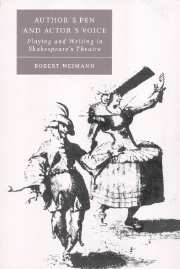Book contents
- Frontmatter
- Contents
- Preface
- Introduction: conjunctures and concepts
- 1 Performance and authority in Hamlet (1603)
- 2 A new agenda for authority
- 3 Pen and voice: versions of doubleness
- 4 Playing with a difference
- 5 Histories in Elizabethan performance
- 6 Hamlet and the purposes of playing
- 7 Space (in)dividable: locus and platea revisited
- 8 Shakespeare's endings: commodious thresholds
- Afterword: thresholds forever after
- Notes
- List of works cited
- Index
6 - Hamlet and the purposes of playing
Published online by Cambridge University Press: 22 September 2009
- Frontmatter
- Contents
- Preface
- Introduction: conjunctures and concepts
- 1 Performance and authority in Hamlet (1603)
- 2 A new agenda for authority
- 3 Pen and voice: versions of doubleness
- 4 Playing with a difference
- 5 Histories in Elizabethan performance
- 6 Hamlet and the purposes of playing
- 7 Space (in)dividable: locus and platea revisited
- 8 Shakespeare's endings: commodious thresholds
- Afterword: thresholds forever after
- Notes
- List of works cited
- Index
Summary
Over the centuries, Hamlet has offered a poetics of representation, a recommendation to actors (as well as to critics) “to hold as 'twere the mirror up to nature” (3.2.21–22). The concept of the “mirror” in this postulate was made to sustain a “purpose of playing” that was designed to fortify areas of continuity and congruity between the poetics of writing and the practice of performance, its cultural function, and its unique object, the imaginary representation on stages. Along these lines, the Shakespearean “mirror” was thought to be all of a piece; “virtue” and “scorn,” the “form and pressure” of things within and without the world of the play were believed to be given, even perhaps before the performance began. There was scarcely any difference made, and no split was allowed, between the discours of the play and the histoire in the play or, to phrase it differently, between the discursive practice within the play at large (the enonciation) and the enoncé, as the sum of what individual characters were made to speak and represent. Often enough, the poet's poetics, the protagonist's thought, the meaning of the story, and its performance in the theatre were all taken to serve one culturally significant purpose.
- Type
- Chapter
- Information
- Author's Pen and Actor's VoicePlaying and Writing in Shakespeare's Theatre, pp. 151 - 179Publisher: Cambridge University PressPrint publication year: 2000



